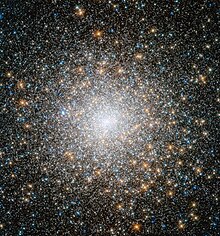Messier 15
|
Globular cluster Messier 15 |
|
|---|---|

|
|
| Image of the globular cluster Messier 15 with the help of the 81 cm mirror telescope of the Mount Lemmon Observatory with an exposure time of 2 hours per color component. The image height is about 20 minutes of arc. | |
| AladinLite | |
| Constellation | Pegasus |
|
Position equinox : J2000.0 , epoch : J2000.0 |
|
| Right ascension | 21 h 29 m 58.3 s |
| declination | + 12 ° 10 ′ 01 ″ |
| Appearance | |
| Concentration class | IV |
| Brightness (visual) | 6.2 mag |
| Angular expansion | 18 ′ |
| Physical data | |
| Integrated spectral type | F3 |
| Redshift | −0.000356 ± 0.000002 |
| Radial velocity | −106.6 ± 0.6 km / s |
| distance | approx. 30,000 ly (approx. 10,000 pc ) |
| Core radius | 0.07 ″ |
| Concentration lg (r t / r c ) | 2.5 |
| history | |
| discovery | DG Maraldi |
| Discovery date | September 7, 1746 |
| Catalog names | |
| M 15 • NGC 7078 • C 2127 + 119 • GCl 120 • | |
Messier 15 (also known as NGC 7078 ) is a 6.2 mag bright globular cluster with an angular extent of 18 ′ in the constellation Pegasus . Its distance is about 33,600 light years , its diameter about 175 light years. The brightest of its at least 500,000 members achieve an apparent magnitude of 12.6 mag. The star cluster wasdiscoveredby Jean-Dominique Maraldi in 1746 and described as a nebulous star . Charles Messier (1764) and Johann Elert Bode could not see any starsinside, which Wilhelm Herschel did notmanageuntil 1783.
In 2002, a core 4000 was solar masses heavy black hole discovered.
In amateur telescopes, M15 appears visually only about 7 'tall, photographically about 12'. The tidal radius, on the other hand, outside of which the gravitation of the Milky Way causes stars to drift, is 21 'to 22' (about 210 light years).

Messier 15 is the first globular cluster in which a planetary nebula was discovered: 1928 Pease 1 . It also contains nine pulsars - remnants of supernovae from when M15 was young. It is also one of the globular clusters with the most variable stars (along with Messier 3 and Omega Centauri ) ; so far one has identified 112.
Web links
Individual evidence
- ↑ a b c SIMBAD query
- ^ NED data for the Messier Objects
- ↑ a b Messier 15 at SEDS
- ↑ Seligman
- ↑ Hubble Discovers Black Holes in Unexpected Places (09/17/2002). In: hubblesite.org. September 17, 2002, accessed January 30, 2015 .
- ↑ Bernd Koch, Stefan Korth: The Messier objects. The 110 classic destinations for sky watchers. Kosmos-Verlag, 213p., ISBN 9783440117439 , Stuttgart 2010

